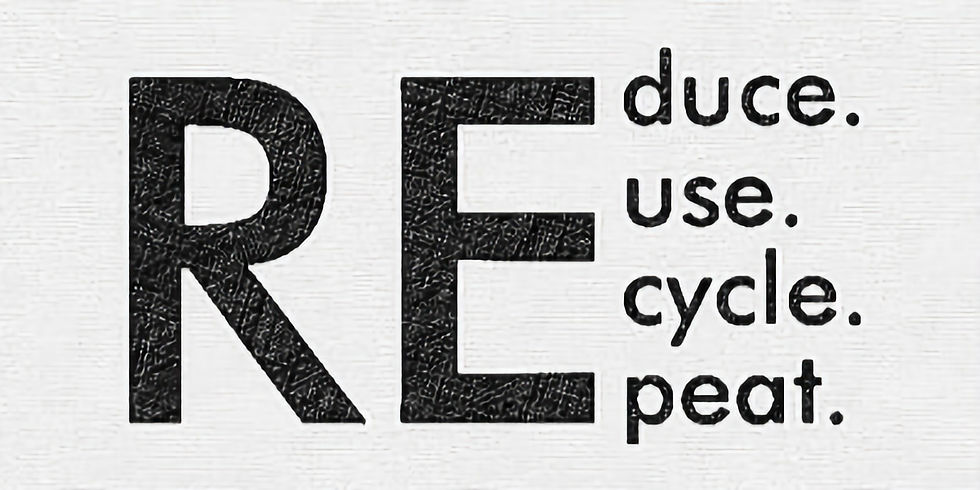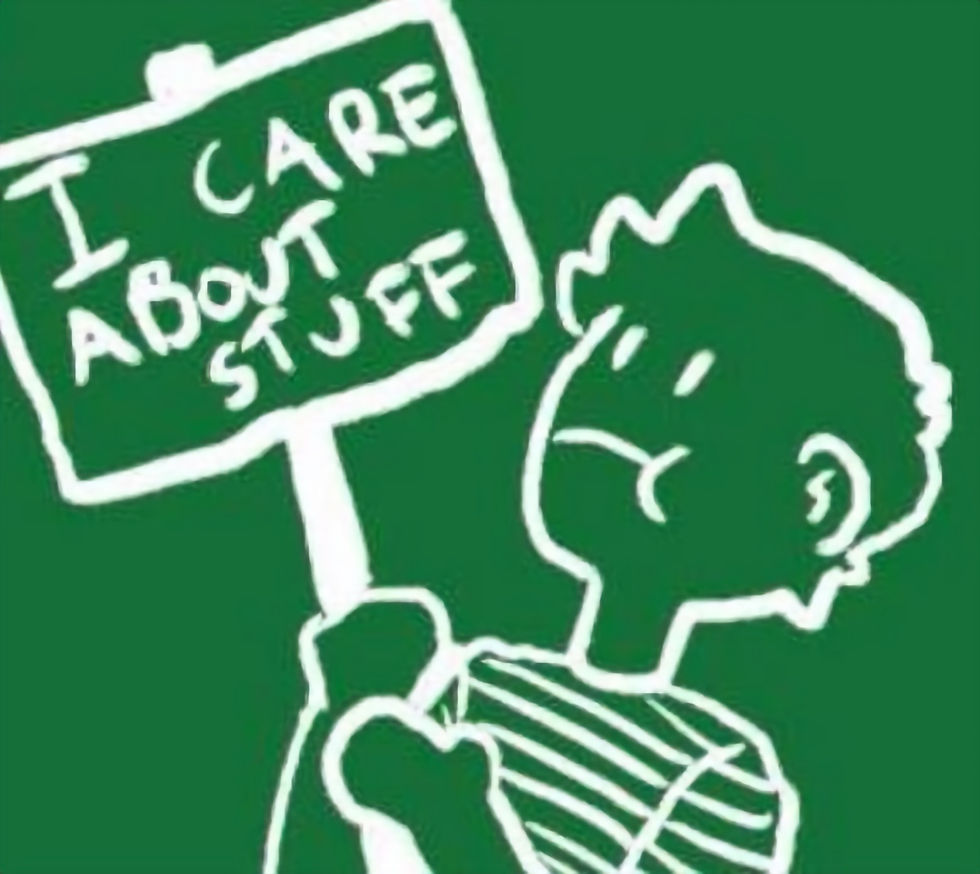#5 SUSTAINABILITY & RECYCLE: 3R (reduce, reuse, recycle)
- Food & Drinks Tips Team
- Feb 7, 2024
- 5 min read

The main culprits of planet pollution are the large industries, but we are accomplices for continuing to finance things we don't want. That's why it's important for each of us to do our part to take care of the Earth, after all, there is no planet B. The slogan "reduce, reuse, recycle" encapsulates three key principles of sustainable waste management to help us saving our world.
REDUCE

The first step in waste management is to reduce the amount of waste we generate in the first place. Reducing habits focus on minimizing consumption and waste generation in order to lessen our environmental impact. Here are some examples of reducing habits:
Minimalism: Adopting a minimalist lifestyle involves owning fewer possessions and prioritizing experiences over material goods. By consuming less, individuals reduce their demand for products and ultimately decrease their environmental footprint.

Conscious Consumption: Making mindful choices about what to buy and opting for quality over quantity can help reduce waste. Before making a purchase, consider if the item is necessary, if it will be used frequently, and if it is ethically and sustainably produced.
Repair and Maintenance: Instead of replacing items when they break or become worn out, consider repairing them. Learning basic repair skills or taking items to professionals for repair can extend their lifespan and reduce the need for new purchases.
Minimal Packaging: Choose products with minimal packaging or packaging that is easily recyclable or compostable. Avoid over-packaged items whenever possible and opt for products with eco-friendly packaging materials.
Borrowing and Sharing: Borrow or share items with friends, family, or neighbors instead of buying new ones. This can apply to tools, appliances, books, and other items that are used infrequently.
DIY (Do-It-Yourself): Making things yourself instead of buying them can be both rewarding and environmentally friendly. DIY projects can include making household cleaners, personal care products, and even clothing or home decor items.

Using food to its fullest: in addition to preventing the waste of edible food, this practice also contributes to financial savings by maximizing the nutritional value of food. Furthermore, by reducing food waste, we decrease the environmental impact associated with food production, transportation, and disposal, while also fostering creativity in the kitchen and demonstrating respect for nature and its resources.
Meal Planning and Portion Control: Plan meals in advance to avoid overbuying groceries and wasting food. Practice portion control to minimize food waste and save money on groceries.
By incorporating these reducing habits into daily life, individuals can play a significant role in reducing consumption, waste, and environmental impact
REUSE:

The next principle encourages us to reuse items whenever possible instead of throwing them away after a single use. This can involve repairing items that are broken, repurposing objects for new uses, or donating items to others who can use them. Reusing items extends their lifespan and reduces the need for new resources to be extracted and manufactured. Here are some examples of reuse habits:
Reusable Containers: Use reusable containers for food storage instead of disposable plastic bags or wraps. This includes using glass jars, stainless steel containers, or silicone food storage bags.
Refillable Products: Opt for refillable products whenever possible. Some stores offer refill stations for items like dish soap, laundry detergent, shampoo, and household cleaners, allowing you to refill your existing containers instead of purchasing new ones.
Repurposing: Get creative and repurpose items for new uses. For example, old jars can be used as vases or storage containers, and worn-out clothing can be turned into cleaning rags or used for crafting projects.

Repurposing leftovers: this practive is crucial for reducing food waste and maximizing resources in the kitchen. By creatively transforming leftover ingredients into new meals, we not only minimize waste but also save time and money while enjoying delicious and diverse dishes. A prime example of this concept can be seen in the television show "Chopped", where contestants are challenged to create new dishes using mystery basket ingredients, often including leftovers or unconventional items. This encourages contestants to think outside the box and showcase their culinary skills by turning disparate ingredients into cohesive and flavorful meals. Similarly, in our own kitchens, we can utilize leftover vegetables, proteins, grains, and sauces to craft inventive dishes such as stir-fries, frittatas, soups, salads, and casseroles. By embracing the challenge of repurposing leftovers, we can reduce food waste, save money, and unleash our creativity in the kitchen, all while enjoying delicious and satisfying meals.

Reusable Shopping Bags: Bring reusable shopping bags with you when you go shopping to avoid using single-use plastic bags. Keep reusable bags in your car or near your front door so you always have them handy.
Hand-Me-Downs: Pass down clothing, toys, books, and other items to family members, friends, or charitable organizations instead of throwing them away. This extends the lifespan of the items and reduces waste.
Upcycling: Upcycling involves transforming old or unwanted items into something new and useful. This can include turning pallets into furniture, transforming old windows into picture frames, or repurposing clothing into accessories.
Mending and Repairing: Repair damaged or worn-out items instead of replacing them. This includes sewing torn clothing, fixing broken appliances, and patching up furniture.
By embracing reuse habits, individuals can prolong the lifespan of items, reduce waste, and contribute to a more sustainable lifestyle.
RECYCLE:

The third principle is the process of converting waste materials into new products to prevent them from ending up in landfills or polluting the environment. Materials such as paper, glass, plastic, and metal can often be recycled into new items, conserving resources and reducing energy consumption compared to producing new materials from scratch. Recycling is an essential component of sustainable waste management and helps to close the loop in the lifecycle of materials.
Separate Recyclables: Set up a designated recycling bin in your home to separate recyclable materials such as paper, cardboard, glass, plastic, and metal.
Know What's Recyclable: Familiarize yourself with what materials are accepted for recycling in your area. Not all types of plastics, for example, may be recyclable in your local recycling program.
Rinse Before Recycling: Rinse out containers and bottles before placing them in the recycling bin to prevent contamination and ensure they can be properly recycled.
Break Down Boxes: Flatten cardboard boxes to save space in your recycling bin and make it easier for recycling facilities to process them.
Remove Non-Recyclable Components: Remove any non-recyclable components, such as plastic caps or metal lids, from containers before recycling them.
Reduce Plastic Usage: Whenever possible, choose products with minimal or no plastic packaging to reduce the amount of plastic waste generated.
Support Recycling Programs: Participate in community recycling programs and initiatives that promote recycling awareness and education.
Buy Recycled Products: Support the recycling industry by purchasing products made from recycled materials whenever possible.
Educate Others: Spread awareness about the importance of recycling and encourage others to adopt recycling habits in their own lives.

Throwing trash away properly is essential for preserving the environment, safeguarding public health, conserving resources, and maintaining the beauty of our communities. It is everyone's responsibility to dispose of waste in a responsible and environmentally friendly manner. Proper waste disposal is crucial for several reasons:
Environmental Protection: Disposing of waste correctly helps prevent pollution of land, water, and air. When trash is thrown inappropriately, it can contaminate soil and water sources, harm wildlife, and contribute to air pollution through incineration.
Human Health: Improper waste disposal can pose health risks to humans. Dumping waste in unauthorized areas can lead to the spread of diseases, attract pests and vermin, and expose people to harmful chemicals and pathogens.
Resource Conservation: Recycling and proper waste disposal allow for the recovery and reuse of valuable resources such as metals, paper, and plastics. By recycling materials, we reduce the need for raw materials extraction and conserve natural resources.
Aesthetic Appeal: Trash scattered in public spaces detracts from the beauty of the environment and can negatively impact tourism, property values, and community well-being. Proper waste disposal helps maintain clean and attractive surroundings.
Compliance with Regulations: Many countries have laws and regulations governing waste disposal to protect public health and the environment. Proper waste management ensures compliance with these regulations and helps avoid legal penalties.
Comments